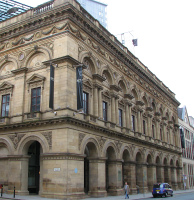
The Manchester Free Trade Hall in Peter Street is among the more significant decorated buildings in England dating from Victorian times. A great Renaissance style block, 9 bays wide to Peter Street, two storeys high with a crowning balustrade it was considered to be of ideal proportions, the apogee of the many Manchester palazzo style buildings, and has a mass and scale giving it a dominance of the street. For the interest of these pages it’s glory is the sculptural decoration – nine tympani (tympanum – a half-round recessed space above a window with an arch on top) of decorative allegorical sculpture on the upper level, and double spandrels (the roughly triangular space between two arches) with coats of arms and naturalistic carving of foliage on the lower level.
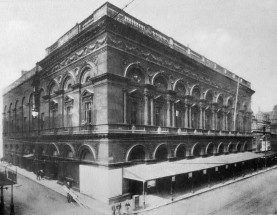 Early view of Free Trade Hall, showing awnings.
Early view of Free Trade Hall, showing awnings.
The building was put up from 1853-56, the architect being Edward Walters, a notable Manchester-based architect, a number of whose warehouses survive in Manchester, in Moseley Street, Portland Street and elsewhere. In recent years a modern addition has been placed on top of the building; something of a shame to lose the proportions of the original building, but if this is what is needed to make the building viable for modern usage and keep it preserved, then so be it.
The sculptor was John Thomas, the most prolific of all Victorian architectural sculptors, whose decorations for buildings are found across the country, including those on the Houses of Parliament (Westminster Palace) and the great pediment of Leeds Town Hall. His work is always of consistently high quality, and the Manchester Free Trade Hall sculpture shows him at his best – you will wish to click on the small pictures below to see the detail, and when you go to visit the real thing, make sure to take some visual aid such as a small pair of binoculars.
Each group consists of a central Classically-draped seated female figure, with around her and behind her the appropriate accoutrements to the idea she represents. The figures are large for their frames, so that the head of each rises above the top of the semicircular border, and with a slightly downward tilt to the head, recognising that they are fairly high above the ground and will be seen from below. The compositions are balanced left to right, but not symmetrical, and other elements of the sculpture are made to overstep the frame, to give a more rich, baroque feel to the whole than would a more severe Classical treatment confining the sculpture rigorously within its designated space.
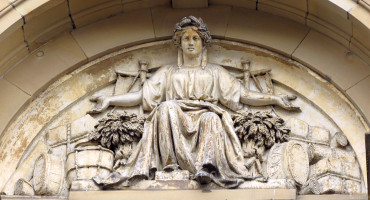 Allegorical figure of Free Trade.
Allegorical figure of Free Trade.
We start with the central group, representing Free Trade of course. This is the most symmetrical composition by far. The allegorical figure of Free Trade sits exactly facing forward, her arms spread wide, her hands open in an expansive gesture. She wears a Classical robe, close around the neck, gathered in at the waist, voluminous folds below over her legs and to the sides. Her sleeves are wide and reach to the elbow, leaving her lower arms bare. Her short hair is crowned with corncobs (maize) forming a wreath, with some pendant cloths to the sides. Next to her are two sheaves of corn, symmetrically placed, as are the sails of the trade ships behind her, and the parcels further outwards to the rear. In front of these are barrel, baskets, and rolls of carpet, differing in the detail but with the most prominent items again symmetrically placed.
Commerce next. She is a youthful figure, with lighter classical drapery, seated on a boat whose curly prow is seen to the left; she holds a rudder in one hand to steer the vessel, and in the other, perhaps a scroll. Around her are a barrel, parcels, a sealed pot, rolled carpets and perhaps a sack. Her hair is braided and long, and her crown is itself the prow of a ship, most noble. While her upper torso faces forward, there is a lovely twist to her supple body, with her legs to the right, her head turned to the left as seen by the viewer, enhancing the sense of youth and vigour.
Industry and Manufactures: The allegorical girl is posed in the opposite way to Commerce, head to our right, legs to the left. Her drapery, lighter than some, leaves her lower arms bear, and there is a brawniness to the lower arm with elbow out to the left, appropriate for a figure emblematic of Industry. Her other hand holds a cotton spinner – a distaff – resting on a heap of parcels. Also on that side are a steam engine, hammer and claw, anvil, and towards the rear, a roll of cloth and a pot. On the other side is a great screw-press, riveted pressure cylinder or boiler, cogweheel, mallet and shovel, all common attributes of Industry.
Industry’s pair is of course The Arts. She has been restored, with the face replaced in whiter stone, giving a rather spooky effect as if wearing a Venetian mask. Again fully draped, but more of a sense that her upper garment is a proper blouse, with collar and tie; she is more sophisticated than her sisters. One arm holds a lyre, resting on a heap of pillar capitals, the solid Corinthian one at the bottom representing Architecture. A palette for Painting is on the floor, resting against a globe for Astronomy, with telescope peeping out behind it. A female bust, also restored, represents Sculpture. On the other side, our figure of the Arts rests her arm lightly on a table of some sort; she holds a pencil, representing Literature, reinforced by the Aladdin’s lamp on the table. A variety of musical instruments complete the ensemble on that side. (Here are links to several other examples of allegorical figures of Architecture, Industry, and Sculpture.)
Four so far, and the other five represent The Continents with which Manchester trades. The allegorical figure of Europe of course is the most sophisticated – she wears a separate collar and belt with buckle, making her drapery more of a formal robe, and has a separate cloak over her shoulders. She wears a crown in her wavy hair, and carries a winged staff with two snakes entwined around it (one is at the bottom and easy to miss), which is the Caduceus, the staff of Hermes (Mercury), here used to indicate Commerce, one of that god’s functions; the parcels on which she sits and next to her also allude to this. The noble horse behind her, and on the other side the Ancient Greek bust of Athena are well-established symbols of Europe. Also on that side are a decorated pot, and a small lyre; Europe’s hand on that side is open in the universal symbol of Trade.
America, by comparison with Europe, is as ever depicted as rather primitive, indicated by her state of undress, with breasts bared and leather straps crossed between them in barbaric fashion. She has a vigorous, well-muscled physique and solid neck appropriate to the adventurer and explorer. Her dress consists of drapery below, with a long fringe beneath which we see her moccasined feet, a short skirt of feathers, and a cloak held to her body by the aforementioned straps. Her hair is long and wild, and she has a Red Indian headdress of erect feathers. She holds the short paddle of an explorer’s canoe, and a bunch of leaves and buds, rather worn, but conceivably a representation of Canadian Maple. Tradeable American produce is piled up on that side – a bale of cotton, jar of molasses, some barrel, and a thick rope. America leans against the flank of a woolly bison, whose head and foreleg are seen to the right, along with a chest with a sun carved upon it, with perhaps a bunch of cigars on top of it, representing the important tobacco industry; the leafy object in the corner may indeed by tobacco leaves. Thus the Victorian image of America.
Africa next, also considered primitive in the Victorian mind, thus also semi-nude, and depicted more exotically barbaric than America with beaded necklace, arm-bands, a cloth headdress and dreadlocks, something of a contrast to the European face and Classical drapery, but as ever, John Thomas manages to carry it off so we do not feel any incongruity. She holds a great Ivory tusk in one hand, and is leaning against a seated lion (lots more lion sculpture is on this page); a parcel reminds us that the uniting theme of the whole is Free Trade. On the right hand side for the viewer, Africa holds, or holds up, a bunch of Ostrich feathers, emerging from a heap of luscious fruit including grapes, cassava and perhaps breadfruit; again, these rest on boxes into which they can be packed for trade purposes. An earthenware pot suitable for wine and a rolled carpet complete this scene, perhaps encompassing South African wine and North African woven wares respectively.
Next we look at Asia. Here we have the exotic and sophisticated – no barbarity here, so she is modestly garbed. She wars a turban, with a crescent at the front, though clothing and face are Classical rather than noticeably Eastern. She holds a small treasure chest in her lap, and supports a great cornucopia with her other arm. She is seated on a camel, seen behind and to the right, and behind that is the prow of a bird-headed trade ship. To our left, we see a tea chest, with exotic fruit on top, an ornamented pot, and rolls of fabric.
Finally Australia, perhaps the most youthful, girlish figure of all, she sits holding a prospector’s spade, with on that side a cow and a nicely carved old tree. On the other side, she holds one of a pair of short heavy horns, resting on a full sheaf of corn, with a woolly sheep at the outermost side, with bales of wool underneath it; behind is perhaps a eucalyptus tree. A proud girl, head erect, braided hair long and unfettered, a wreath of corn in her hair.
The lower storey is much less ornate than the upper, yet the carvings of foliage around the shields between each pair of arches is of extremely high quality and shows John Thomas’s eye and fondness for natural forms. Each roughly triangular space has and elegant entwined branches of olive and oak to either side, every leaf and every panel uniquely different. Unlike the figure sculpture, this flora decoration and shields continues round the side of the building.
Naturalistic spandrel carving.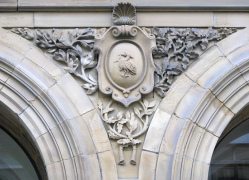
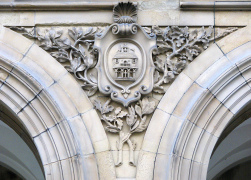
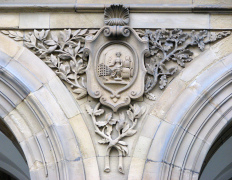
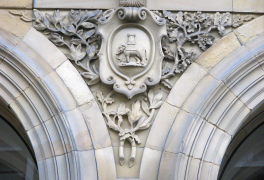
Here are illustrated several of the panels, together with their shields. The ones chosen here show a Liver bird; an ancient house or more likely a church with a small bell tower; a factory scene with a seated girl, presumably a worker, a bale of wool next to her, and a trading ship in the background; and an elephant with castle as a howdah, presumably indicative of trade with India.
We end by noting that among various festoons, shells, and other minor decoration, each of the rectangular windows at second floor level, thus below the tympana, has its own little pediment on the entablature of which is a little female head.
This page was originally part of a 'sculpture of the month' series, for Dec 2013. Although the older pages in that series have been absorbed within the site, if you would wish to follow the original monthly series, then jump to the next month (Jan 2014) or the previous month (Nov 2013). To continue, go to the bottom of each page where a paragraph like this one allows you to continue to follow the monthly links.
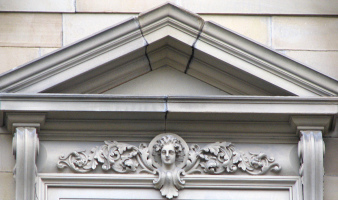 Window entablature with sculpted head.
Window entablature with sculpted head.
Manchester sculpture pages - Albert Square
Sculpture in some towns in England // Sculptors
Visits to this page from 13 Mar 2014: 15,023